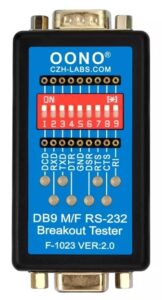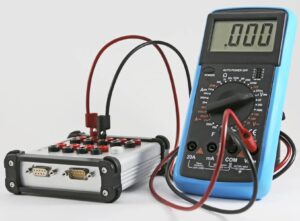Just when you thought the trusty breakout box would fall victim to high-speed digital signals, it lives on.
One of the problems with cables and connectors is that, by design, they generally conceal the copper of the wires they handle. While that’s a good thing, it makes checking those wires for signal parameters—voltage, current, rise/fall, timing, and so on—difficult to impossible.

Enter the breakout box: a small, inexpensive, usually passive piece of test equipment. Breakout boxes bring those signals out to where they can be observed with probes, while also passing the signals through. I owned two of those. One was for the once-common 25-wire RS-232 connector (Figure 1), the second was for the four-wire telephone line using an RJ-11 connector (Figure 2). Today, we use 9-pin RS-232 connections; breakout boxes are readily available (Figure 3), even if the DB9 designation should be DE9.
Breakout boxes are fun to use. They make it easy to observe a signal line with a voltmeter for basic checks, or an oscilloscope if needed. Some of the RS-232 boxes are more “advanced,” with LEDs on the signal lines to show their state and activity. Some even have small DIP switches so you could disable and then jumper key lines — all which gave you the joyous feeling of being able to both observe and control.

Today’s high-speed, fast-slewing, small-swing signals, sensitive as they are to capacitance, load, and even temperature, can’t tolerate the relatively heavy hand, figuratively speaking, of just any casual probing you might do with a breakout box. If you want to observe a signal going to or through a connector, you probably should have designed in the necessary buffered test points in your prototype design and fabrication. Alternately, you’ll likely need to get a relatively expensive test box that picks off the signals you want to observe, while not interfering with their paths and transitions in a way that the signals would notice. Having said that, breakout boards are indeed available for high-speed buses such as USB, Ethernet, HDMI, and others.

As higher-speed buses have become mainstream, I thought the breakout box or board would vanish. Not so. Even though we live in a world of fast-moving signals and their precision connectors that don’t like to be touched, breakout boards and boxes have adapted to minimize problems caused by stray capacitance and other issues. This $399 breakout box from Testuto (Figure 4) provides banana jacks for connecting test instruments.
Breakout boxes are still valuable tools for working engineers and hobbyists. These and other test tools which have been around “forever” and look like they’ll just keep on giving, whether in their original form.
Do you have “old” test instruments you still use when checking cables and connectors? Are there any you haven’t seen or used in a long time, probably won’t use again, or wish you hadn’t thrown them away?







